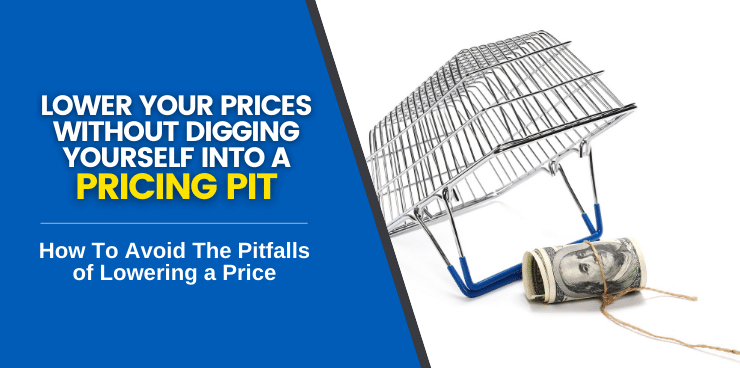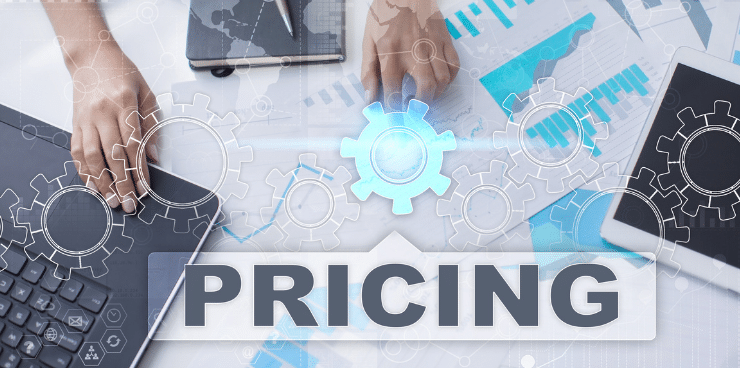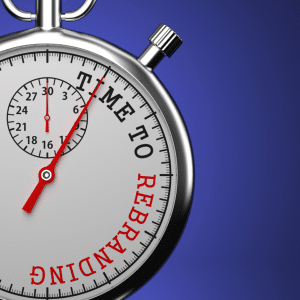
Imagine your favorite brand decides to lower the price of one of their most popular products. You’re probably thinking, “I’ll buy it now!” But what if that same brand also lowers the quality of their product? You might not be so eager to purchase it anymore.
This is a common trap companies fall into when they lower prices. In an effort to increase sales, they lower their prices but also lower the quality (or quantity) of their product. This can lead to disappointed customers and a decrease in sales in the long run.
To avoid this trap, companies need to focus on maintaining the quality of their product even if they do lower the price. Customers will be more likely to continue purchasing a product they trust and are satisfied with, even if it costs a bit more.
Like the example given above, the rest of this article will get into how businesses can avoid the pitfalls of lowering a price.
“Cheaper Price” or “Lower Price”?
You’ve probably heard both terms, “cheaper price” and “lower price,” but which one is more accurate? The answer is not so clear:
- Cheaper: Less expensive than something else of the same kind or a perceptually lower quality option.
- Lower: A lower price for perceptually the same thing or paying a lower price because you are getting way more for the money you are paying.
If you are looking to prop up your perceived value, you call the competitor cheaper. If you are the lower price, you are less expensive. You want to be perceived as better quality and a better value.
The real trick is to determine if it is actually the same thing. If not, which one is better? If yours is better, you must prove it. Can you make it more money, but provide waaaaay more value?
One of our clients is a roofing company. They offer a variety of different roof solutions, from asphalt to metal. One of the metal roofing products has a 50 year non-prorated warranty without all the goofy “get out of jail free” terms and conditions, making it a real value. Now the asphalt costs 2-3 time LESS to install, including materials, but lasts 7-8 time less than the metal product.
By rights, the asphalt is a cheaper product, and the more expensive metal roof is actually a lower price over the substantially longer lifetime of the product.
You can run your luck and hope to sell the cheap roof again and again every 10-15 years, making a meager margin, or you can sell the premium roof product for a healthy profit today.
How to Sell Lower Prices Strategically and Avoid Pitfalls
Lower prices can be a tough decision for any business owner, but sometimes it is necessary to stay competitive when you’re not the Cheap Charlie in town. When done correctly, persuasively higher pricing that feels lower because your value proposition is so darn customer heavy will lead to increased revenue and market share. However, there are several potential pitfalls that businesses should avoid when implementing this kind of price strategy.
One of the most common mistakes businesses make when promoting a lower price is not being strategic about it. It is important to consider how to position yourself as the lower price for what it is your customer receives. How are you so different than your competitor? What will your salespeople say when they are challenged? What do you have ready to go in your back pocket to defend your lower price position, because your “lower price” is higher than everyone else? If your salespeople aren’t ready when they are hit with the inevitable raised eyebrows, your closing ratio will plummet.
To be strategic in a lower price message, you need to understand your costs, create a market pricing plan, and emphasize product lifetime value. You should also consider Plan B, including price matching, bundling, and alternative products solutions to default to in an effort to retain the sale.
Understand Your Costs
The first step in developing a strategic price reduction is to understand your costs. This will help you determine how much you can price your solution to make your desired profit. To do this, you need to calculate your cost of goods sold (COGS). This includes the cost of materials, labor, commissions, permits, services, subs, financing costs, and accommodate for any discounts.
Once you know your COGS, you can calculate your gross profit margin. This is the percentage of revenue that is left after COGS are deducted from total sales. For example, if your product sells for $1000 and it costs $500 to deliver, then your gross profit margin would be 50%.
You can also use gross profit to calculate your break-even point. This is the number of units you need to sell to cover your fixed costs. For example, if fixed costs were $500 to deliver 100 units, then your break-even point would be 500/100, or 5 units.
Once you know your gross profit margin and break-even point, you can determine how much you need to sell each month to start making bank.

Create a Pricing Plan
Once you know how much you can lower your prices without hurting your business, it’s time to create a pricing plan. This will help you stay on track and make sure that you’re pricing things right. Here are a few things to keep in mind when creating your pricing plan:
- The types of pricing strategies you use: This includes, for example, cost-based pricing, value-based pricing, or market-based pricing.
- Your gross profit margin: This is the percentage of each sale that you keep as profit.
- Your break-even point: This is the number of sales you need to make to cover your costs.
- The prices of your competitors: You’ll want to stay competitive, but not so low that you’re cutting into your profits. Competitor-based pricing is something to consider.
- The price elasticity of your product or service: This is how much demand for your product or service changes when the price changes. Do you have a high degree of price elasticity (meaning people are sensitive to price changes)? If so, you’ll want to be careful not to raise your prices too much.
Emphasize The Advantage of Product Features and Benefits
When you’re not the lowest price, it’s important to make sure that your customers understand what they’re getting for their money. Be sure to they know the features and benefits of your product or service that they care about so that they know exactly what they’re paying for. More importantly, however, make sure you tie these features and benefits back to the advantage they get from them.
For example, a person doesn’t go into Home Depot to buy a 1.5” cup bit to own a cup bit (feature). Most sales trainers would argue that they want a 1.5” hole (benefit).
Has there ever been a moment in your life when you wanted a 1.5” hole? Me neither.
But I do want a hole for my door knob to fit into that I can use to open and close, even lock a door with (advantage). You are not selling features and benefits. You are selling the ends, not the means.

Rebranding
If you’re struggling to sell a product or service at a certain price point, it may be time to consider rebranding. This can be a major undertaking, but it may be necessary if your brand is associated with Cheap Charlie pricing that isn’t working for you anymore. Rebranding can help you:
- Differentiate your product from the competition: If you’re selling a product that’s very similar to others on the market, rebranding can help you make your product stand out, particularly when paired with unique value stacks and bundling solutions.
- Attract a new customer base: If your current customer base isn’t interested in your product or service, rebranding can help you attract new customers. This can be especially true when you’re targeting a different market segment than you were originally.
- Change customer perceptions of your product: If customers have a negative perception of your cheap products, rebranding can help change that. This can be important if your product has had quality issues in the past or if it’s not seen as being innovative.
- Improve customer loyalty: If customers are loyal to your brand, they’re more likely to continue using your products or services, even when there are cheaper alternatives available. Rebranding can help improve customer loyalty by making your brand more recognizable and trusted.
- Update your image to match current market trends: If your brand image is outdated, rebranding can help you update it to match current market trends. This can be important if you want to appeal to a younger demographic or if you’re expanding into new markets.
Offer Price Matching
If you’re worried about losing customers to a competitor’s cheaper prices, you can offer price matching. This way, you still make a sale. But what about the profit, you’re wondering?
To do this, you don’t need to keep an eye on your competition’s prices at all. You just need to be ready, able, and willing to not only match their price, but beat it without a second guess.
For one of our clients, we cheerfully offer a 2 year club membership (valued at $480) on top of any legitimate competitors quoted price. Once the sale is completed, they skillfully go after the much easier to close second sale, including all the necessary code upgrades and most desirable accessories identified during the sales process.
Bundles
Another way to deliver a substantially lower price at a higher price than your competitors is with the almighty bundle. This involves grouping together complimentary products and services, then selling them at a discounted group rate.
For example, if an HVAC company sells a new air conditioner and furnace, they could bundle it with AeroSeal®, duct cleaning, surge protection, and a 5 year club membership. While the stand alone products may normally garner a 75 point margin, you could sell the hole kit and kaboodle for a great bundle price and still pull in 55 points on the bundle sale, after finance fees, commissions, and discounts, of course.
This is an effective way to increase your profits while still providing a massive advantage to customers. It also allows you to offer a variety of products or services at a no-brainer price point, which will attract new customers through your raving loyal fans.
 Is Lower Price the Only Way to Improve Your Sales?
Is Lower Price the Only Way to Improve Your Sales?
Sales are the lifeblood of any business, so, understandably, entrepreneurs are always looking for ways to increase them. For many businesses, the go-to solution is to lower prices to attract more customers and improve revenue, forsaking bottom-line profits.
Just selling at lower prices may give you a short-term sales boost, but the most successful companies in America are all at the top of the price scale in market.
Delivering a lower price message based on a well crafted value proposition is far more profitable and realistically the ONLY WAY to convert more sales at a higher average sale and profit.
So, what can we learn from this? Lower price is a state of mind. You don’t have to be the cheapest guy in town to win the business. You have to be the best bang for the buck.
Here are a few strategies when looking to increase your perceptual ROI in the eyes of your customers:
- Improve your customer service: Customer service is what sets you apart from your competition. If you can provide a better buying experience, from the ads you run to the the way you answer the phone to the last spec of dust you clean up before you leave the house. If you want premium prices, you need to deliver a premium service.
- Offer more value: Instead of cheap prices, offer more value. WAAAAY MORE VALUE. Think of what value you would say, “whoa, that’s great value”, then double that value again. Then figure out how much it costs to deliver that value and create efficiencies to weave it into the fabric of your buying experience.
- Improve your marketing: If you’re not getting the word out about your business, no one will know you exist. Make sure you’re doing everything you can to market your business effectively. This means you’re going to need to leverage mass media properly and have a great story that is told better than you are likely able to tell it yourself.
- Be creative: There are endless possibilities when it comes to improving sales. Get creative and brainstorm some ideas with your team. You may be surprised at what you come up with. Implementing even just one strategy that makes the customers real felt needs explode will help you boost sales exponentially.
Pricing is hard. It’s the lynchpin to so much of your success or failure because its the most critical measuring device when all other things are perceived equal by your customer base.
Make sure you’re take the time to evaluate your options and choose the best strategy for your business, or get me to help you expedite the process and get your pricing right today for accelerated growth without losing conversions or profits. Book a demo.
- Futuristic Game for the Ad Masters - July 11, 2024
- Classical Conditioning: Pavlov’s Dog in Advertising - June 20, 2024
- Hear, See, Speak No Advertising - June 9, 2024
